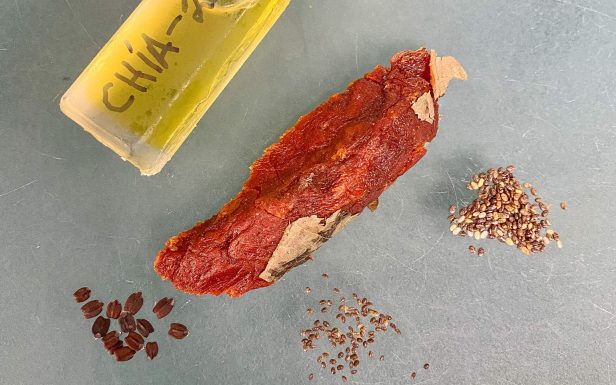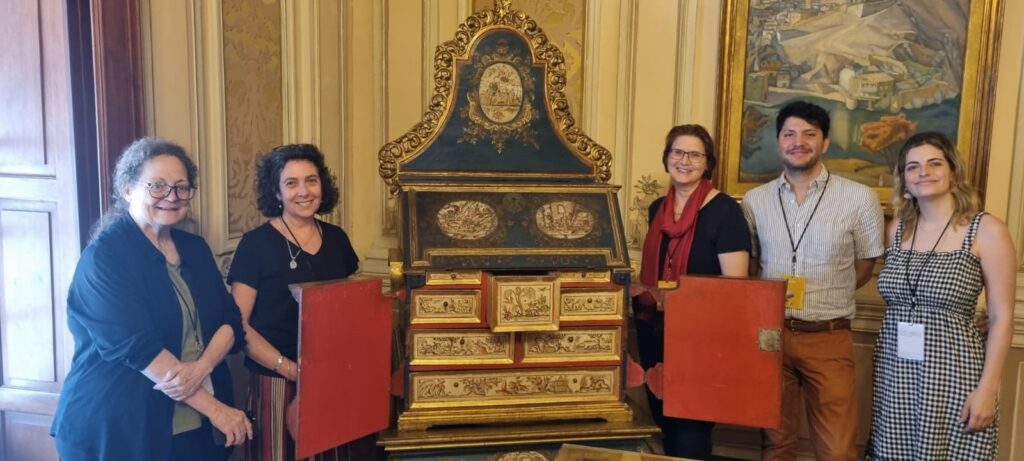Chia Oil in Art
A novel tripartite approach to biomolecule analysis for the identification of unknown artistic materials applied to the use of chia oil in art from New Spain


18th century Mexican lacquerware tray (Batea), José Manuel de la Cerda. The Marriage of the Virgin oil on canvas, ca. 1690, José Sanchez.
About the project
Chia (Salvia Hispanica L.) has been documented as a staple in Mesoamerican cultures for over 4500 years, thought to be as important as corn, and valued for nutritional, medicinal, ritualistic, and artistic uses.1,2 Medicinally, pre-Hispanic records document the primary uses of the chia plant to treat ophthalmic and respiratory disorders, and malnutrition.3,4 Chia seeds have been found in archaeological sites as offerings dedicated to the gods and its known use in body paint suggests the importance of chia in religious rituals.5 Since about 1200 CE Mexican lacquer made with pigmented chia oil has been used to coat jicaras (vessels and receptacles made from gourds) to create lustrous, durable surfaces. The Spanish presence in Mexico from the 16th to the 19th century brought unprecedented global interactions to the region and influenced the evolution of the uses of chia and traditional art forms. During this period, there was a substantial decrease in chia cultivation which ethnobotanists hypothesize reflects the decline of the native population, the replacement of crops with non-native plants, and the modification of the diet in New Spain as consequence of European contact.6 In general, the information on the use of chia during the Viceregal period is disjointed and not well documented.
During the 300 hundred years of Spanish presence, the indigenous technique of Mexican lacquer was influenced both by Asian and European designs and incorporated local and foreign materials to embellish trays, wooden boxes, cabinets, and chests, all forms that were introduced for the Spanish market.7,8 Particularly in the 19th century, these objects were accessioned by European and American museums, but as tastes changed the knowledge base to identify them was lost, only regaining attention in recent decades. Many museums are discovering that decorated objects previously identified as ‘painted’ or Spanish are indeed Mexican lacquerware.1
Despite regulations, a list of art materials written by Juan Correa, an important Mexican painter from the late 17th century, included chia oil as an alternative medium to linseed oil, raising the question of whether traditional Mexican art materials continued to be used throughout the Spanish occupation. Mexican paintings from the Viceregal period were absent from the Met’s holdings before 2014 and Gallery 749 Collecting the Arts of Mexico in the American Wing currently exhibits the museum’s paintings collection for the first time.
In addition to paintings, chia oil is known to have been used in other Mesoamerican handcrafts. Chia oil, often mixed with the fatty extracts from the parasitic insect, aje (Llaveia axin axin), is the traditional material used as a ground, where it was layered with minerals, and final gloss coating in Olinalá and maque lacquerware, and this ancient technique is still used in the production of contemporary maque. A wooden writing cabinet on a table from the Hispanic Society of America collection is an exceptional example of Mexican lacquer and is on display at the Met in the American Wing Gallery 717.


Artist materials including chia oil, seeds, and aje. The Marriage of the Virgin, ca. 1690, José Sanchez painting cross section showing paper used in an old lining treatment, gilding, oil layer, light brown paint layer, and two oil grounds. Image credit: José L. Lazarte
The customary approach for biological material analysis in a museum environment is a combination of Fourier transform infrared spectroscopy (FTIR) and gas chromatography-mass spectrometry (GC-MS).9–5 FTIR can classify the materials as protein, polysaccharide or fat/oil but is of little help in identifying a specific oil or protein. GC-MS analysis can further identify oils common in Western art, such as linseed and walnut oil.9–12 However, many non-Western oils used in artworks cannot be distinguished using this approach. GC-MS analysis can provide amino acid or protein marker information; unfortunately, this approach fails repeatedly to identify complex mixtures and unknown materials and is never species-specific. This project uses chia oil as a drying medium in art to demonstrate a multifaceted approach where multiple classes of biomolecules (i.e. not just proteins or lipids) are investigated simultaneously. Currently, there is no scientific method to identify chia oil or other non-Western drying oils and it cannot be identified using traditional approaches.
This project is a collaboration between ARCHE, the Met’s Department of Paintings Conservation, Department of Scientific Research, and the American Wing, the Hispanic Society Museum & Library, and Weill Cornell Medicine. This project also includes collaboration with professors at Universidad Nacional Autónoma de México and Grupo Artesanal Tecomaque, as well as other museums in North America and Europe.
While multiple varieties of wild and cultivated chia exist, each plant within the Salvia Hispanica L. species has unique DNA. Next generation sequencing is being used for DNA barcoding of chia by Dr. Chris Mason’s lab at Weill Cornell Medicine.
The main components of chia oil are triacylglycerides (TAGs) and fatty acids, both of which are within the class of biomolecules called lipids. Lipidomics methods, using matrix-assisted laser desorption/ionization mass spectrometry (MALDI-MS) and high resolution tandem mass spectrometry (MS/MS), are being adapted by the Met and the University of Bordeaux to perform TAG fingerprinting and fatty acid identification to determine the lipid profile specific to chia oil for identification of chia oil in art.
The Met and the University of Bordeaux are performing proteomics analysis using the highly sensitive and specific techniques of MALDI-MS and liquid chromatography tandem mass spectrometry (LC-MS/MS) to allow for the identification of chia seed proteins in cultural heritage objects. Although protein molecules are not a major component of chia oil, chia seeds are incredibly high in protein and seed proteins can be remnant in chia oil after its rudimentary extraction process. The high sensitivity of proteomics analysis allows for detection and characterization of any chia-specific proteins in the oil mixture.

From L to R: Ronda Kasl (Met Curator of Latin American Art), Monica Katz (independent scholar), Julie Arslanoglu (Met Scientist), Jose Luis Lazarte Luna (Met Paintings Conservator), and Aleksandra Popowich (Met Scientific Research Associate) and Museo Amparo in Puebla
Cahill, Joseph P. 2003. “Ethnobotany of Chia, Salvia Hispanica L. (Lamiaceae).” Economic Botany 57 (4): 604–18.
Sosa-Baldivia, Anacleto, Guadalupe Ruiz-Ibarra, Raúl René Robles de la Torre, Reyna Robles López, and Aurora Montufar López. 2018. “The Chia (Salvia Hispanica): Past, Present and Future of an Ancient Mexican Crop.” Australian Journal of Crop Science 12 (10): 1626–32.
Duran, Fray Diego. 1994. “The History of the Indies of New Spain.” University of Oklahoma Press.
Sahagun, Fray Bernardino. 1950. “Florentine Codex: General History of the Things of New Spain.” University of Utah Press.
Vázquez-de-Ágredos Pascual, Maria Luisa, María Teresa Doménech Carbó, and Antonio Doménech Carbó. 2008. “Resins and Drying Oils Os Precolumbian Painting: A Study from Historical Writings. Equivalences to Those of European Painting.” ARCHÉ Publicación Del Instituto de Restauración Del Patrimonio de La Universidad Politécnica de Valencia 3: 185–90.
Sosa-Baldivia, Anacleto, Guadalupe Ruiz-Ibarra, Raúl René, Robles De La Torre, Reyna Robles López, and Aurora Montufar López. 2018. “The Chia (Salvia Hispanica): Past, Present and Future of an Ancient Mexican Crop.” AJCS 12 (10) 1835-2707.
Pérez Carrillo, Sonia, and Carmen Rodríguez de Tembleque. 1997. “Oriental and European Influences.” In Lacas Mexicanas: Coleccion Uso y Estilo, edited by Ruth Lechuga, Isabel Medina, Sonia Pérez Carrillo, Carmen Rodríguez de Tembleque, Marta Turok Wallace, and Carlo Bravo Marentes. Mexico City: El Museo Franz Mayer y Artes de México.
Ocaña Ruiz, Sonia I. 2019. “The Impact of European Lacquer on Eighteenth-Century Colonial Mexico.” Studies in Conservation 64 (sup1): S53–61.
Gimeno-Adelantado, J. V., R. Mateo-Castro, M. T. Doménech-Carbó, F. Bosch-Reig, A. Doménech-Carbó, M. J. Casas-Catalán, and L. Osete-Cortina. 2001. “Identification of Lipid Binders in Paintings by Gas Chromatography: Influence of the Pigments.” In Journal of Chromatography A, 922:385–90.
Mills, John S. 1966. “The Gas Chromatographic Examination of Paint Media. Part i. Fatty Acid Composition and Identification of Dried Oil Films.” Studies in Conservation 11 (2): 92–107.
N. Stolov, G. De W. Rogers, in: Boston: Museum of Fine Arts, Vol. 15, 1973, p. 213.
R. Pancella, R. Bart, Kunsttechnol. 1989 “Identification des liants organiques dans les couches picturales par chromatographie en phase gazeuse.” Zeitschrift für Kunsttechnologie 3 (1):101-111.
Katz, Monica. 2016. “Colonial Spanish American Lacquered Objects in the Collection of the Hispanic Society of America.” In AIC Wooden Artifacts Group Postprints. Montreal.
Arroyo, Elsa, and Pablo Amador. 2017. “Aproximación a Los Materiales y Las Técnicas Del Pintor Juan Correa.” In Juan Correa. Su Vida y Su Obra, Tomo, edited by Elisa Vargaslugo, I, 205–39. Mexico City: IIE-UNAM.
Turok W., Martha, and Carlos Bravo Marentes. 1997. “Patrimonio Artesanal En Riesgo.” In Lacas Mexicanas, 53–65. Mexico City: Museo Franz Mayer/Artes de México.
Ramírez León, Lilia F. 2016. “Diseñando Responsabilidades Con Maque.” Revista Rúbricas Puebla: Universidad Iberoamericana de Puebla No. 10: 12–19.
Vandenabeele, Peter, Mayahuel Ortega-Avilès, Dolores Tenorio Castilleros, and Luc Moens. 2007. “Raman Spectroscopic Analysis of Mexican Natural Artists’ Materials.” Spectrochimica Acta – Part A: Molecular and Biomolecular Spectroscopy 68 (4): 1085–88.
Peláez, Pablo, Domancar Orona-Tamayo, Salvador Montes-Hernández, María Elena Valverde, Octavio Paredes-López, and Angélica Cibrián-Jaramillo. 2019. “Comparative Transcriptome Analysis of Cultivated and Wild Seeds of Salvia Hispanica (Chia).” Scientific Reports 9 (1): 1–11.
van der Werf, Inez D., Cosima D. Calvano, Francesco Palmisano, and Luigia Sabbatini. 2012. “A Simple Protocol for Matrix Assisted Laser Desorption Ionization- Time of Flight-Mass Spectrometry (MALDI-TOF-MS) Analysis of Lipids and Proteins in Single Microsamples of Paintings.” Analytica Chimica Acta 718: 1–10.
Coman, Cristina, Fiorella Andrea Solari, Andreas Hentschel, Albert Sickmann, René Peiman Zahedi, and Robert Ahrends. 2016. “Simultaneous Metabolite, Protein, Lipid Extraction (SIMPLEX): A Combinatorial Multimolecular Omics Approach for Systems Biology.” Molecular and Cellular Proteomics 15 (4): 1453–66.
Research performed in collaboration with…
The “A Novel Tripartite Approach to Biomolecule Analysis for the Identification of Unknown Artistic Materials Applied to the Use of Chia Oil in Art from New Spain” project has been made possible in part by a major grant from the National Endowment for the Humanities: Democracy demands wisdom.











